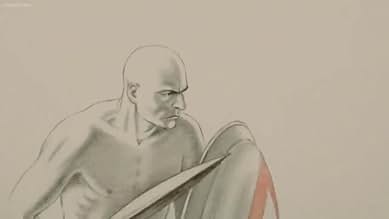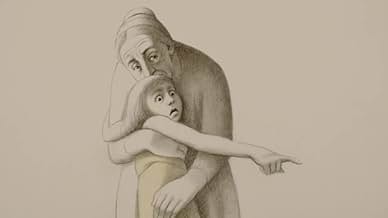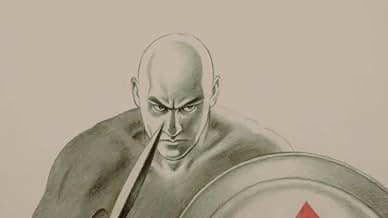IMDb RATING
6.5/10
1.3K
YOUR RATING
Taking place 2,400 years in the past, Prologue depicts a brutal battle between two teams of Spartan and Athenian warriors.Taking place 2,400 years in the past, Prologue depicts a brutal battle between two teams of Spartan and Athenian warriors.Taking place 2,400 years in the past, Prologue depicts a brutal battle between two teams of Spartan and Athenian warriors.
- Director
- Writer
- Nominated for 1 Oscar
- 2 nominations total
Featured reviews
This laughably inaccurate short was to be the introduction to a cartoon adaption of Lysistrata. The press material says: "Man against man and sword against spear, the soldiers are determined to sacrifice themselves for a greater purpose"
"man against man"? Classical age conflict between Greek city states was NOT melee pairing it was phalanx warfare. That is almost ritualized and surprising low violence, with an estimated 5% casualty rate per battle. Violence was almost entirely confined to combatants and phalanx fighting was essentially set piece pushing matches. There was virtually no "man against man" fighting at all.
That the cartoons was utterly inaccurate in detail as well is also important since the the details go to bigger issues. The greaves ALL hoplites wore and the type of shield (the word hoplite means shield warrior), and the standard length spear ALL had were for fighting in FORMATION. And the formation (the phalanx) reflected the citizen warrior fighting in a unified group -- as part of their responsibility to their city state and their fellow citizen warriors. Breaking off for melee pairings as in "Prologue" as it itself an act against one's fellow citizens since it compromised the phalanx.
Each citizen had to privately own the infantry arms and amour. This was an important part of egalitarian underpinnings of most city states.
The reason the Eight to Fifth century BC city states did not subjugate huge amounts of foreigners is because their fighting method, citizen, non professional solders who had their own equipment. Assyrians, Persians, later Macedonian Greeks, and empire period Romans all had armies were paid or impressed soldiers, who did not own their weapons and who were permanent professional soldiers. those other forces did NOT have to get back to the fields or regular jobs" like Lysistrata era Greeks had to.
The cartoonist completely misses the point: If warfare today was like classical age Greek warfare, with its lack of full time professional soldiers, with its lack of central armories, but instead owned arms, with its "winning" by having 5% or so of combatants die on the field, and victory declared, instead of "total war" with its lack of razing cities in most cases -- we would be a LOT better off.
The author/cartoonist, and anyone interested, ought to read the preeminent scholar on Lysistrata era Hoplite warfare: Victor Davis Hanson's "Hoplites: The Classical Greek Battle Experience" so they do not get confused.
"man against man"? Classical age conflict between Greek city states was NOT melee pairing it was phalanx warfare. That is almost ritualized and surprising low violence, with an estimated 5% casualty rate per battle. Violence was almost entirely confined to combatants and phalanx fighting was essentially set piece pushing matches. There was virtually no "man against man" fighting at all.
That the cartoons was utterly inaccurate in detail as well is also important since the the details go to bigger issues. The greaves ALL hoplites wore and the type of shield (the word hoplite means shield warrior), and the standard length spear ALL had were for fighting in FORMATION. And the formation (the phalanx) reflected the citizen warrior fighting in a unified group -- as part of their responsibility to their city state and their fellow citizen warriors. Breaking off for melee pairings as in "Prologue" as it itself an act against one's fellow citizens since it compromised the phalanx.
Each citizen had to privately own the infantry arms and amour. This was an important part of egalitarian underpinnings of most city states.
The reason the Eight to Fifth century BC city states did not subjugate huge amounts of foreigners is because their fighting method, citizen, non professional solders who had their own equipment. Assyrians, Persians, later Macedonian Greeks, and empire period Romans all had armies were paid or impressed soldiers, who did not own their weapons and who were permanent professional soldiers. those other forces did NOT have to get back to the fields or regular jobs" like Lysistrata era Greeks had to.
The cartoonist completely misses the point: If warfare today was like classical age Greek warfare, with its lack of full time professional soldiers, with its lack of central armories, but instead owned arms, with its "winning" by having 5% or so of combatants die on the field, and victory declared, instead of "total war" with its lack of razing cities in most cases -- we would be a LOT better off.
The author/cartoonist, and anyone interested, ought to read the preeminent scholar on Lysistrata era Hoplite warfare: Victor Davis Hanson's "Hoplites: The Classical Greek Battle Experience" so they do not get confused.
War is hell and it always has been. I think that sometimes when animation is used, it is thought to be cartoon-like in the kindest sense. So when the realities of face to face battle are portrayed we seem to believe that we've somehow been betrayed by the filmmaker. There are no winners here, only the slaughter of our opponents and the end is meaningless. The face of he child and the old woman, wonderfully portrayed, are what should be etched in our memories. There is nothing clean about war and this shows it in spades.
This was a very unusual nominee at the screening because it was shown last (after the commended shorts) and carried a lengthy warning that children should not stay in the theater to see it. After seeing "Prologue", I completely understand and it is not appropriate for children. However, I also think it's not appropriate to be seen by anyone!
The film is gorgeously animated using pencils and a bit of colored pencil. I loved this style of animation and the film was beautiful...yet I give it a D rating. This is because there is almost no story at all and the film was just god-awful and joyless.
It consists of four people fighting some sort of itsy-bitsy war in ancient times. Like some of these ancient warriors, two of them were naked, but their genitalia didn't offend me. After all, that is how some of them most likely fought. What bothered me was that there really wasn't any story...just four guys viciously killing each other...very viciously. There is blood galore as well as a lovely scene near the end when one of them stabs the other to death by plunging a sword into the other guy's testicles! Or was it his anus...either way, it was just incredibly nasty and gross...and seemingly pointless.
UPDATE: The Oscar went to "Bear Story".
The film is gorgeously animated using pencils and a bit of colored pencil. I loved this style of animation and the film was beautiful...yet I give it a D rating. This is because there is almost no story at all and the film was just god-awful and joyless.
It consists of four people fighting some sort of itsy-bitsy war in ancient times. Like some of these ancient warriors, two of them were naked, but their genitalia didn't offend me. After all, that is how some of them most likely fought. What bothered me was that there really wasn't any story...just four guys viciously killing each other...very viciously. There is blood galore as well as a lovely scene near the end when one of them stabs the other to death by plunging a sword into the other guy's testicles! Or was it his anus...either way, it was just incredibly nasty and gross...and seemingly pointless.
UPDATE: The Oscar went to "Bear Story".
Prologue (2015)
*** (out of 4)
Richard Williams bizarre animated short managed to pick up an Oscar nomination and it's somewhat hard to believe considering how violent and gory the picture is. The film takes place over two thousand years ago as Spartan and Athenian fighters do battle to the death.
It seems that reviews are rather mixed on this one and it's easy to see why. The film contains some full frontal nudity, graphic violence and some gore, which will certainly have your eyes wide open but at the same time I guess this might be too much for some even in an animated form. For the most part I thought the six minutes went by fast and I'd argue that the animation itself was quite good. There's really no story to speak of but just violent battle sequences with blood flowing.
*** (out of 4)
Richard Williams bizarre animated short managed to pick up an Oscar nomination and it's somewhat hard to believe considering how violent and gory the picture is. The film takes place over two thousand years ago as Spartan and Athenian fighters do battle to the death.
It seems that reviews are rather mixed on this one and it's easy to see why. The film contains some full frontal nudity, graphic violence and some gore, which will certainly have your eyes wide open but at the same time I guess this might be too much for some even in an animated form. For the most part I thought the six minutes went by fast and I'd argue that the animation itself was quite good. There's really no story to speak of but just violent battle sequences with blood flowing.
10tavm
Just found this, what I found out was the late Richard Williams' final film, on Facebook. It begins with a bug going out one flower to another and then segues to a bunch of men-one completely naked, one with some armor-fighting with swords and a few other weapons. I'll stop there and just say this was quite excellent in the way the figures seem life-like with great action and drama to spare. R.I.P. Mr. Williams
Did you know
- TriviaThis is the first mature cartoon by Richard Williams to depict graphic violence, blood and full frontal nudity.
- ConnectionsFeatured in The Oscar Nominated Short Films 2016: Animation (2016)
Details
- Runtime
- 6m
- Color
- Aspect ratio
- 1.78 : 1
Contribute to this page
Suggest an edit or add missing content



















